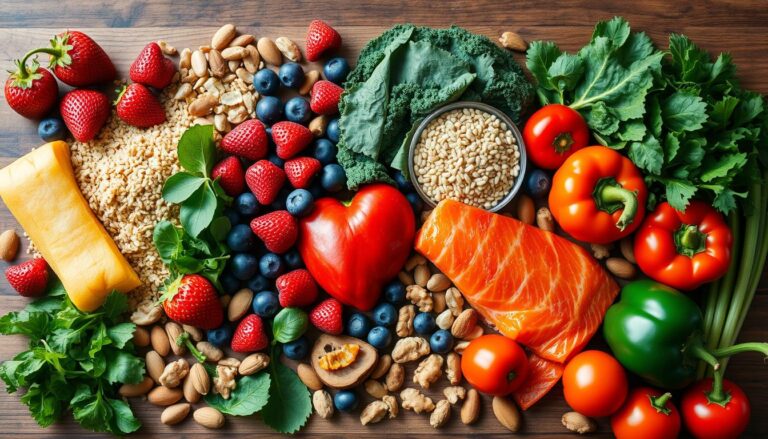Having a slim waist is more than just looking good in clothes. Too much belly fat, called visceral fat, can lead to serious health issues. The CDC says too much sugar and processed snacks can make us fatter. But, what if making a few simple changes could help?
Studies show eating more fiber and walking a bit each day can help. Even small actions like taking the stairs can burn calories. This article shares ways to lose belly fat safely, without using fad diets.
Every extra pound of belly fat can harm your heart. Eating protein instead of carbs can help you burn more calories. HIIT workouts, like short sprints, are better for losing belly fat than long, slow runs. And, getting enough sleep is key to losing fat.
Learn how combining these tips can help you live longer and lose weight. It’s all about making small, smart changes.
Key Takeaways
- Visceral fat increases diabetes and heart disease risks
- Reducing sugar and ultra-processed foods fights insulin resistance
- Strength training burns more calories than fat long-term
- Seven hours of sleep daily optimizes fat loss
- High-fiber diets lower belly fat and diabetes risk
Understanding Belly Fat: Why It’s Different from Other Fat
Getting rid of belly fat needs a clear understanding of fat types. Visceral fat is deep inside the belly and is different from subcutaneous fat under the skin. This difference affects health and how to lose belly fat.
The Difference Between Visceral and Subcutaneous Fat
- Visceral fat: Surrounds organs like the liver and pancreas, linked to disease risks.
- Subcutaneous fat: Pinchable fat under the skin, less harmful but important for health.
Health Risks Associated with Excess Belly Fat
| Risk Factor | Condition |
|---|---|
| High visceral fat | Type 2 diabetes |
| Excess abdominal fat | Heart disease |
| High cortisol levels | Metabolic syndrome |
How Hormones Influence Abdominal Fat Storage
Insulin resistance can lead to fat storage. Cortisol, the stress hormone, increases visceral fat during stress. Menopause also changes fat distribution to the belly due to hormone changes. Eating right and getting enough sleep helps balance hormones and burn belly fat.
Targeted strategies can tackle these biological factors. Exercise and nutrition plans focused on visceral fat can reduce health risks well.
What is the Best Way of Dealing with Belly Fat?
There’s no single “magic bullet” for getting rid of belly fat. The optimal strategies for losing belly fat need a complete approach. This includes diet, exercise, and lifestyle changes. Research shows that lasting results come from consistent, science-backed methods.
“Effective stomach fat remedies must align with individual health needs and long-term habits,” states the Department of Health and Human Services.
Success comes from several key areas:
- Creating a calorie deficit through mindful eating
- Incorporating 150+ minutes of moderate exercise weekly
- Managing stress and sleep patterns to regulate cortisol

| Factor | Action | Impact |
|---|---|---|
| Diet | Reduce refined carbs and added sugars | Lower insulin spikes and fat storage |
| Exercise | Combine HIIT with strength training | Burn visceral fat and preserve muscle mass |
| Behavioral | Sleep 7-9 hours nightly | Reduce hunger hormones like ghrelin |
Go for slow weight loss of 1-2 pounds a week. Focus on whole foods, staying hydrated, and regular activity. Steer clear of extreme diets. Instead, aim for habits that boost your metabolic health. Keep an eye on your waist size (men
The Science Behind Effective Belly Fat Reduction
To lose belly fat, it’s important to understand how fat loss works. Fat cells release triglycerides during lipolysis. This process breaks them down into fatty acids and glycerol. These then go into the bloodstream and are used by muscles for energy.
This explains why losing fat overall can slim down your midsection. It’s not just about spot treatments.
How Fat Loss Actually Works
Your body burns visceral fat first when you’re on a calorie deficit. Studies show people on low-carb diets lose more weight than those on low-fat diets. This is because of changes in how the body uses energy.
But to reduce belly fat, you need a complete plan, not just one trick.
Why Spot Reduction is a Myth
Exercises like crunches won’t get rid of belly fat. They can make your core muscles look better, but they don’t burn fat. Research shows fat loss happens all over the body, not just in one spot.
To really slim down your midsection, you need to focus on your whole body.
The Role of Metabolism in Burning Abdominal Fat
Basal metabolic rate (BMR) is how many calories you burn at rest. It’s 60-75% of your daily calorie use. Having more muscle mass increases BMR because muscle burns more calories.
Thermogenesis, the heat from digestion, also helps burn fat. For example, eating protein can increase thermogenesis by 15-30%. This helps with fat burning.
Nutrition Strategies for Targeting Stomach Fat

Nutrition is key in reducing stomach fat. Making smart food choices can help manage belly fat and improve health. Here are some science-backed tips for better eating habits.
Research shows soluble fiber absorbs water to slow digestion, promoting satiety and reducing calorie intake. Flaxseeds and avocados provide this fiber, which correlates with lower abdominal fat levels.
Eating anti-inflammatory foods is essential. Fatty fish like salmon have omega-3s that fight inflammation. Add leafy greens and nuts to your meals. Studies show these foods can help shrink your waistline in 12 weeks.
Protein boosts your metabolism by 20-30% during digestion. Eggs, lean poultry, and legumes help keep muscle and make you feel full. A 2021 review found eating more protein can reduce belly fat. Try to eat 25-30g of protein at each meal.
- Choose complex carbs like quinoa and sweet potatoes for sustained energy
- Avoid refined sugars – limiting to under 10% of daily calories
- Replace sugary drinks with herbal teas or infused water
Drinking water helps with fat metabolism by supporting kidney function and reducing bloating. Drinking 500ml of water before meals can make you feel 13% fuller, studies show. Stay away from sugary drinks that add empty calories.
Combine these tips with mindful eating. Keep track of what you eat and eat at regular times to avoid late-night snacking. Small, steady changes in your diet can lead to noticeable waistline reductions in 8-12 weeks.
Powerful Exercises That Target Your Core and Burn Belly Fat
To burn belly fat, you need to focus on both core strengthening and full-body workouts. Exercises like planks and Russian twists help tone muscles. But, to lose belly fat, you also need to burn calories and eat right. Losing visceral fat means losing fat all over, not just in one spot.
Movements like squats and deadlifts work many muscles at once. This raises your metabolism. Studies show that doing strength training two times a week helps keep muscle and lose fat. High-intensity intervals (HIIT) also increase calorie burning for hours after working out.
- Bear Crawl: 3 rounds of 20–30 seconds
- Dumbbell Thruster: 3 sets of 6–8 reps
- Assault Bike Sprints: 5 rounds of 30 seconds on/90 off
A 12-week study showed moderate-to-vigorous exercise reduced abdominal fat by improving insulin sensitivity and metabolic health.
For the best results, mix 150 minutes of moderate cardio with strength training each week. Burpees or kettlebell swings are great because they burn calories and keep muscles strong. Don’t just do crunches; focus on exercises that work your whole body.
For lasting belly fat loss, be consistent, not just intense. Start with 2–3 workouts a week that include squats, rows, and lunges. Add a diet rich in fiber and drink plenty of water to boost your metabolism. Losing fat is a long-term change, not a quick fix.
HIIT Workouts: The Ultimate Belly Fat Burning Technique
High-Intensity Interval Training (HIIT) is a workout that alternates between intense effort and rest. It burns a lot of calories and targets belly fat. Studies prove it boosts belly fat reduction by keeping your body’s metabolism high even after you stop exercising.
- 30 seconds of burpees, followed by 30 seconds of rest.
- 45 seconds of mountain climbers, then 15 seconds of rest.
- Repeat this cycle 5 times, increasing intervals by 10 seconds weekly for progression.
HIIT uses excess post-exercise oxygen consumption (EPOC) to keep your metabolism high for hours. This helps burn fat, including the dangerous kind around your organs.
Adding strength training to HIIT makes it even more effective. A sample workout could be:
- 20-second sprint on a stationary bike
- 30-second plank hold
- 10 resistance band rows
Doing this 3 times a week helps you lose fat and keep muscle. The American College of Sports Medicine suggests keeping HIIT workouts under 30 minutes to avoid overdoing it. This ensures you can keep losing belly fat without getting too tired.
Lifestyle Changes That Drastically Reduce Abdominal Fat
Making small changes in your daily life can lead to big results in slimming down your midsection. Chronic stress and poor sleep can make your belly fat grow. Bad habits like sitting too much can also slow down your progress. There are proven ways to tackle these issues and see faster results.
Stress management is critical. The stress hormone cortisol makes your body store fat around your belly. Studies show that mindfulness and deep breathing can lower cortisol by up to 20%. Cognitive behavioral therapy can also help change how you react to stress, preventing unhealthy eating.
Getting enough sleep is key to a healthy waistline. Adults need 7-9 hours of sleep each night for better hormone balance. A study found that those sleeping less than five hours ate 385 more calories a day, making it harder to lose belly fat. Poor sleep messes with hunger hormones, making you want to eat more.
- Sitting for over eight hours daily reduces metabolic rate by 90%, boosting visceral fat accumulation
- Screen time before bed suppresses melatonin, worsening sleep quality
- Skipping breakfast elevates insulin resistance, favoring fat storage
Start making changes: move for 5 minutes every hour, choose healthy snacks, and relax before bed. These consistent changes can lead to lasting results in your belly fat, thanks to better metabolism and less inflammation.
Supplements and Natural Remedies for Enhanced Belly Fat Reduction
There are no FDA-approved drugs just for belly fat. But, some supplements and natural methods might help. Green tea extract, with EGCG and caffeine, could boost your metabolism and burn fat. It might help you lose belly fat while you’re resting.
Two proven options are soluble fiber supplements and probiotics. Soluble fiber, like psyllium husk, makes you feel full and lowers inflammation. Probiotics, like Lactobacillus, improve gut health. This can help with metabolism and fat storage. These methods are backed by science.
- Green Tea Extract: Look for standardized extracts with 300-400mg EGCG daily.
- Soluble Fiber Supplements: 10-15g daily may improve insulin sensitivity and fat metabolism.
- Probiotics: Strains like Bifidobacterium and Lactobacillus, taken with meals, support gut health.
Be careful with products that promise quick results. Always talk to a healthcare provider before trying new supplements. Natural remedies should help, not replace, a healthy diet and exercise. Trust science over sales pitches.

Keep in mind, how well supplements work varies from person to person. Use effective stomach fat remedies along with exercise and healthy eating. Stick to supplements that have solid scientific backing for the best results.
Common Mistakes That Prevent Effective Stomach Fat Loss
Effective belly fat loss tips often fail when common pitfalls go unaddressed. Understanding these errors ensures progress toward slimming down your midsection remains on track. Here’s how to avoid them:
Overtraining: When Exercise Works Against Your Goals
Too much exercise without rest can raise cortisol, a stress hormone that adds to belly fat. It can also weaken your immune system and increase the chance of injury. Experts say to do strength training twice a week and moderate cardio five times a week. Avoid doing high-intensity workouts back-to-back.
Signs you’re overtraining include feeling tired all the time and muscle soreness that lasts too long.
Diet Misconceptions That Keep Your Belly Fat Stuck
- Extreme calorie deficits below 1,200 calories/day slow metabolism
- Low-fat diets often substitute fats with refined carbs and added sugars
- Overestimating exercise-induced calorie burn (e.g., jogging burns ~100 kcal/mile for average adults)
Why Crash Diets Make Belly Fat Worse Long-Term
| Crash Diet Effects | Sustainable Approach |
|---|---|
| Metabolic slowdown (5-10% reduction in BMR) | Gradual 15-20% calorie deficit |
| Muscle loss (up to 25% of initial weight loss) | Strength training preserves lean mass |
| Increased hunger hormones (ghrelin spikes) | High-protein diets reduce appetite by 25% |
Slow and steady changes are better than drastic ones. Focus on whole foods, good sleep, and managing stress to keep your hormones balanced. It’s consistency, not how hard you try, that leads to lasting slimming down your midsection results.
Creating Your Personalized Belly Fat Reduction Plan
To lose belly fat, you need a plan that fits your life. Start by looking at your current habits and setting goals that are achievable. Begin with small changes, like eating more fiber or walking every day. Remember, sticking to it is what matters most.

Good abdominal fat burning techniques mix healthy eating, exercise, and lifestyle changes. Eat whole foods, cut down on sugar, and do strength training to keep muscle. Take measurements every week and tweak your plan as you go.
A 2012 Johns Hopkins study found low-carb diets led to faster visceral fat loss compared to low-fat diets.
Here are some tips backed by science:
- Find key areas to change using the table below.
- Do cardio and strength training together for better results.
- If you hit a plateau, check your hormones and talk to a doctor.
| Approach | Low-Carb Diet | Low-Fat Diet |
|---|---|---|
| 6-Month Weight Loss | 28.9 lbs average | 18.7 lbs average |
| Muscle Loss | ~2-3 lbs lean tissue | ~2-3 lbs lean tissue |
| Vascular Health | Improved artery function | Improved artery function |
Genetics and health issues like diabetes need special plans. Mix moderate exercise with eating mindfully. Stay away from quick fixes and focus on lasting changes. Regular health check-ups are key to safety and success. Remember, losing belly fat is good for your heart, so keep going, even if it’s slow.
Timeline Expectations: How Quickly Can You Realistically Lose Belly Fat?
Effective stomach fat remedies need patience. Experts say losing belly fat should be done safely and steadily. Aim to lose 1–2 pounds of body weight each week. But, you might not see changes in your belly fat for 4–6 weeks.
How fast you lose weight depends on many things. These include your metabolism, age, and how much you weigh to start. For example, men might lose weight faster because they have more muscle. After losing 1–2 pounds a week at first, it might get harder to lose weight. This is because your body gets used to the changes.
The CDC says it’s better to focus on steady habits than quick fixes. They advise against trying to lose weight too fast.
“A 2020 review of 121 diets showed no single method outperformed others long-term. Consistency matters more than speed.”
Use measurements and how your clothes fit to track your progress. Gaining muscle from strength training can help you lose weight while making your waist smaller. Try to eat 500 calories less each day to lose about 1 pound a week. Also, remember to:
- Do strength training 2–3 times a week to keep your muscle
- Drink lots of water (91–125 oz daily) to help your metabolism
- Get enough sleep and manage stress to keep your cortisol levels in check
Methods that promise quick results, like losing 7 pounds in a week, often just make you lose water, not fat. Good belly fat loss tips focus on slow, steady changes. Celebrate small wins like clothes fitting better or having more energy. With time and the right strategies, most people see real changes in 3–6 months.
Conclusion: Maintaining Your Results for Long-Term Success
For lasting belly fat loss, it’s key to find strategies that fit into your daily routine. Visceral fat, which is harmful, needs more than quick fixes. The National Weight Control Registry found that lasting weight loss comes from daily activity, portion control, and choosing low-fat foods.
Getting rid of belly fat means adopting proven habits. The Mediterranean diet is rich in fiber, healthy fats, and protein, which helps your metabolism and keeps you full. Adding 2,000–3,000 kcal/week of activity, like HIIT or strength training, boosts calorie burn and muscle preservation. Don’t forget, sleep is important for controlling hunger hormones.
Only 1–3% of people keep off weight loss for good. To avoid weight gain, focus on small, lasting changes. Meal prep at home and mindful eating can help. Behavioral programs with 12–20 weekly sessions also build lasting habits. High-protein diets help keep muscle while losing weight.
Long-term success means tackling the root causes of weight gain. Small changes, like eating low-Glycemic Index foods or going for daily walks, add up over time. It’s not just about losing weight; it’s about living a healthy life. Making sustainable choices today can prevent diseases like diabetes and heart disease tomorrow.





